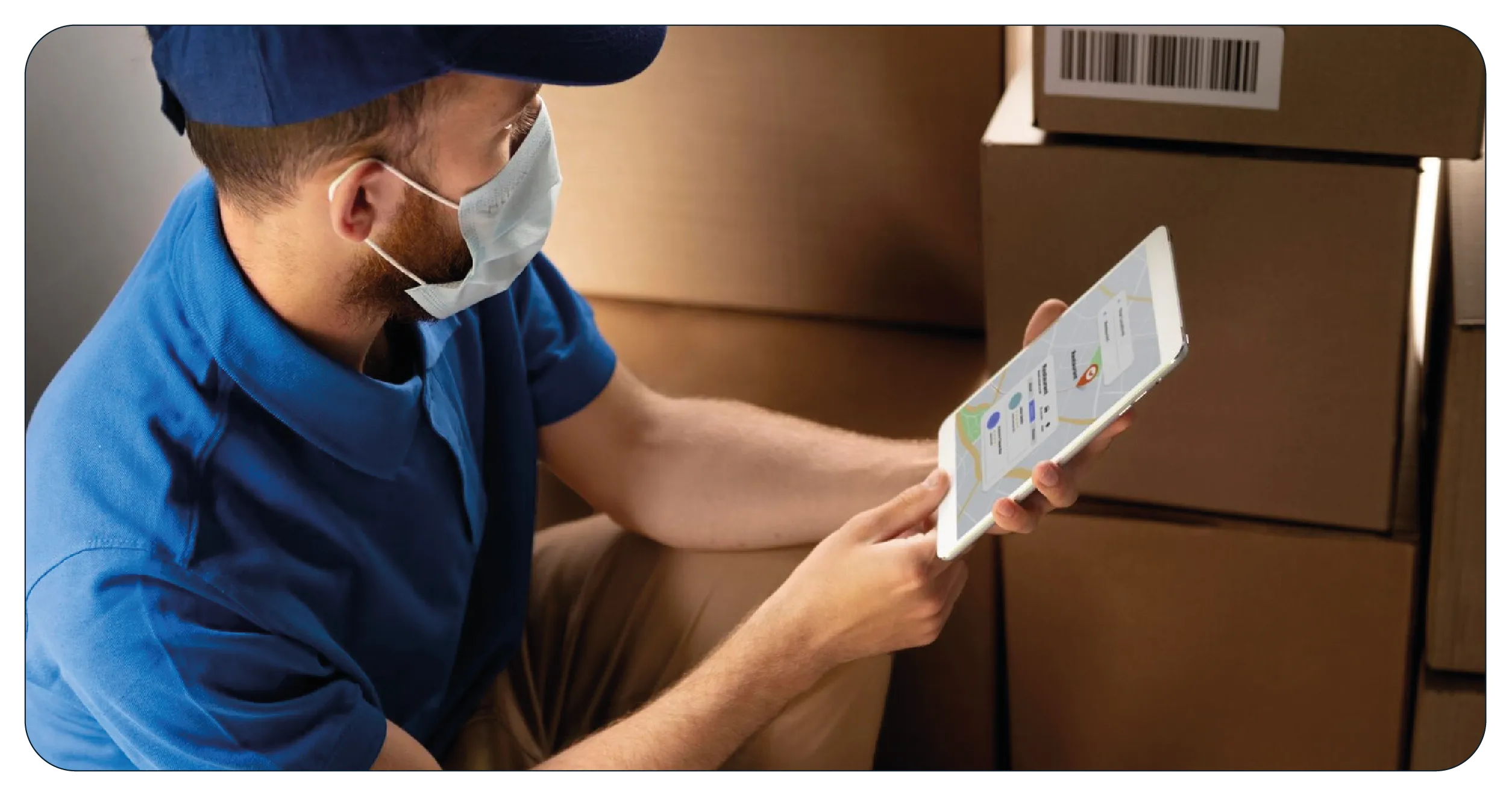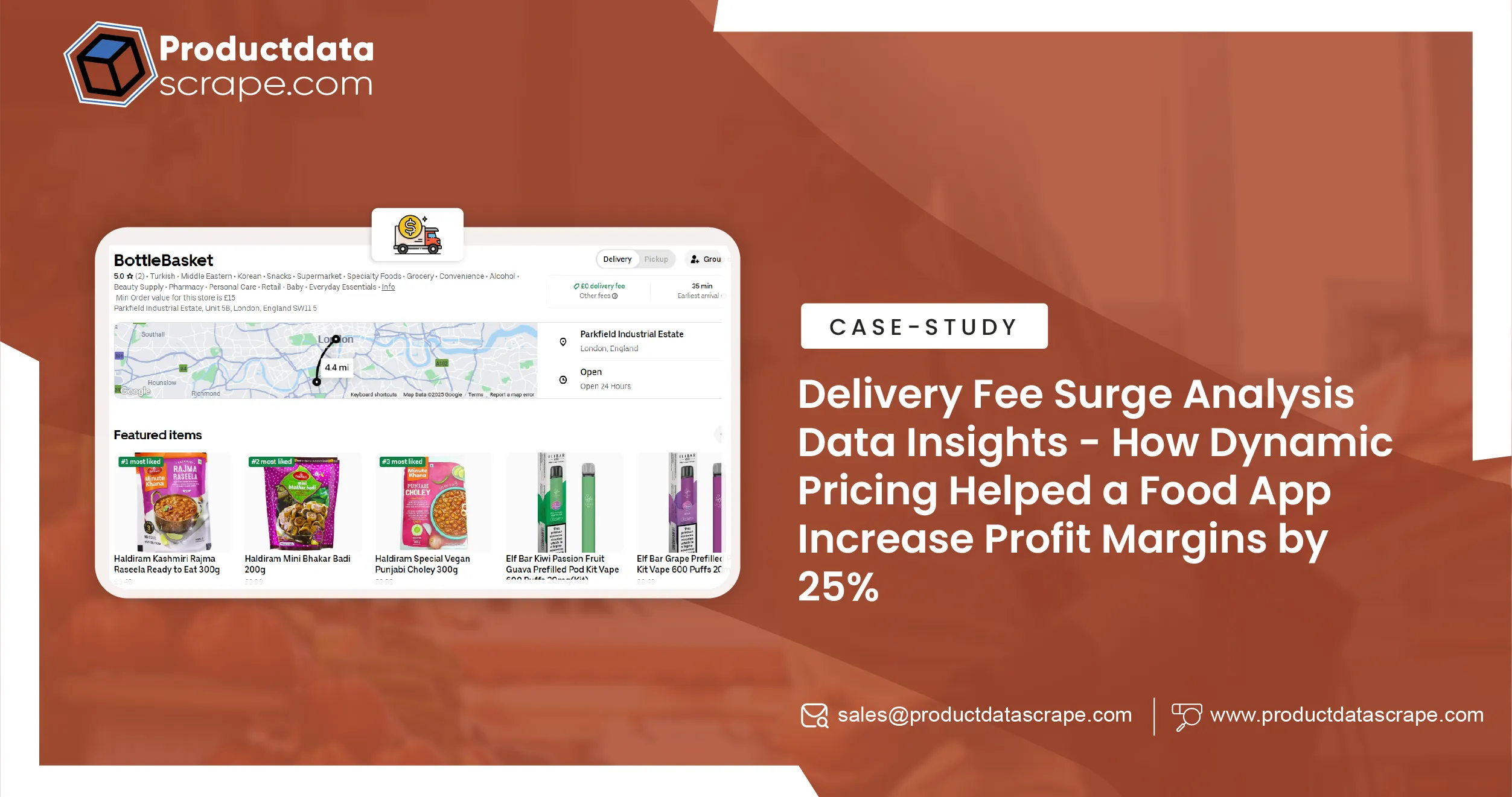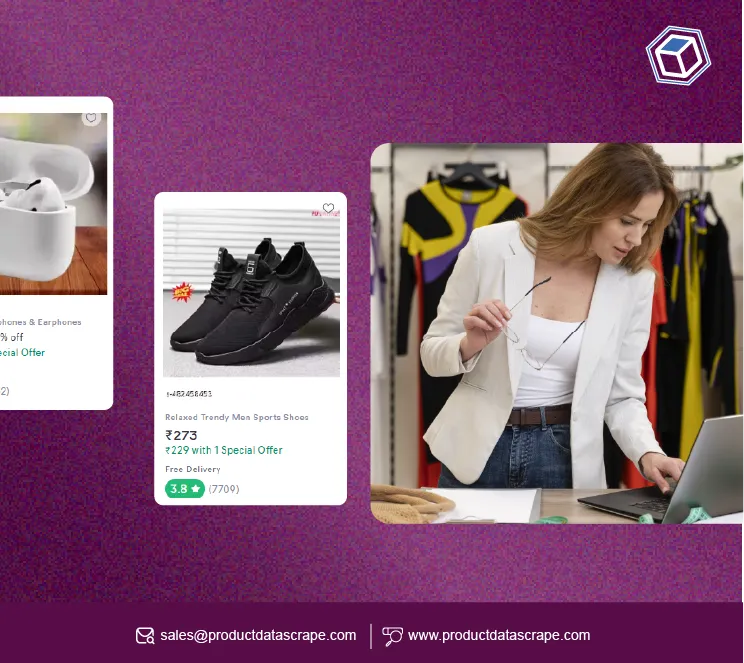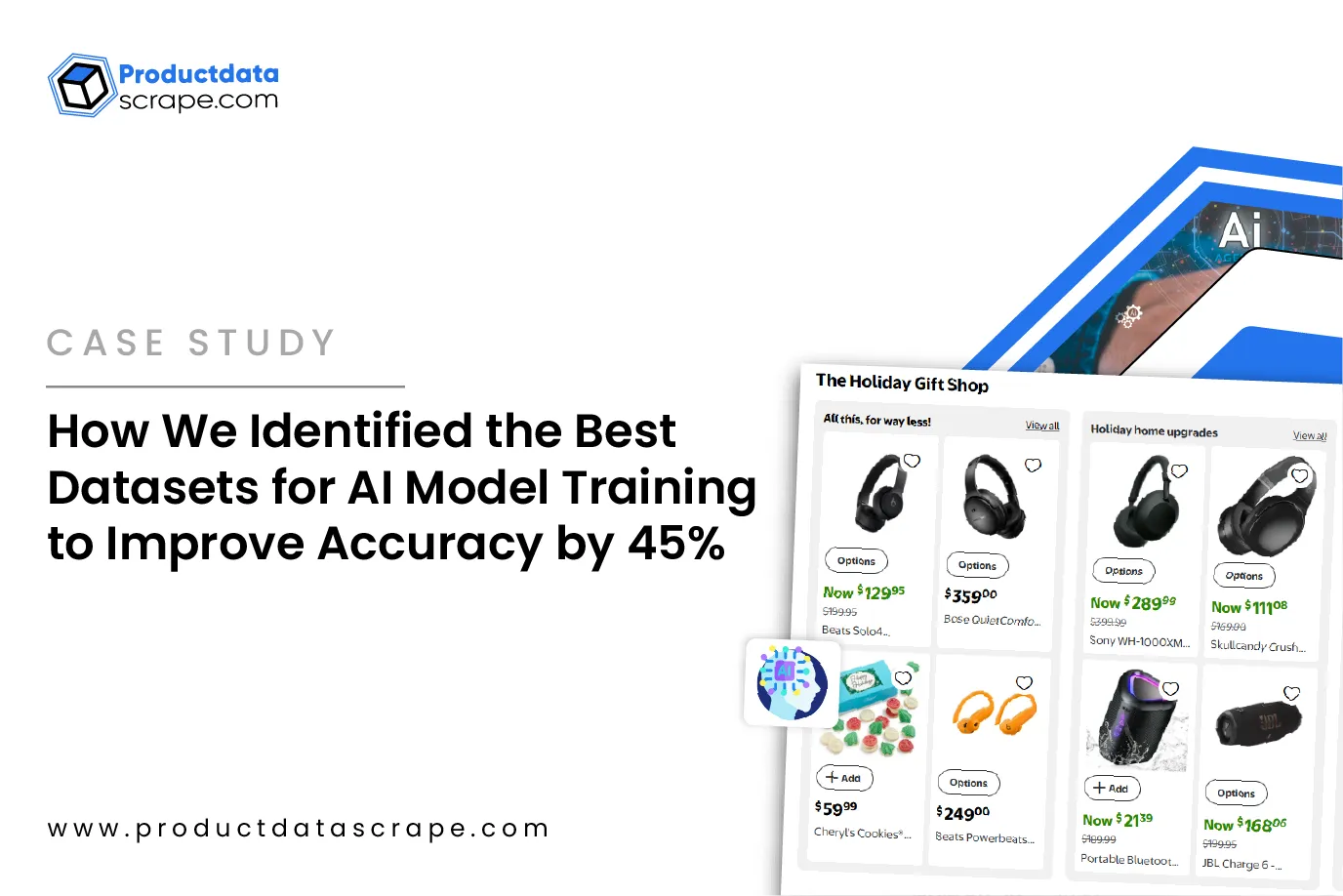Quick Overview
Using Delivery Fee Surge Analysis Data Insights, our team partnered with a leading grocery
delivery platform to uncover key patterns behind fluctuating delivery fees during peak hours. By
analyzing a >grocery store dataset , we identified real-time factors influencing surge pricing,
including demand spikes, delivery distance, and time-of-day variations. Over a focused 3-month
engagement, we helped the client optimize their dynamic pricing model, leading to smarter fee
adjustments and improved customer retention. The outcome was remarkable — a 25% boost in profit
margins, 18% faster delivery turnaround, and a 22% drop in customer drop-offs during high-demand
periods.
The Client
The client, a growing player in the online grocery delivery sector, was facing intense
competition and fluctuating delivery costs due to unpredictable demand surges. With several
established brands dominating the market, efficient pricing became a critical differentiator.
The company’s existing delivery model relied on static pricing, which failed to reflect
real-time demand and operational strain during peak hours.
Rising fuel prices and delivery delays were eroding profit margins, while customers were
becoming more sensitive to fee variations. The leadership recognized the need to Scrape
Real-Time Delivery Pricing Data to understand how fees changed across locations, times, and
competitor apps. This transformation was essential not just to stay competitive, but to build a
data-driven pricing strategy that balanced affordability and profitability.
Before partnering with us, the client’s pricing approach lacked agility — manual fee updates,
delayed reactions to surges, and poor visibility into demand patterns. Our analytical model
empowered them with actionable insights, enabling dynamic fee adjustments and better demand
forecasting, setting the foundation for scalable growth.
Goals & Objectives

The primary goal of this project was to transform how the client managed surge pricing using
Delivery Fee
Surge Analysis Data Insights. From a business standpoint, the focus was on achieving
scalability, speed,
and accuracy in delivery fee adjustments to maximize profitability and customer satisfaction.
The client
sought a competitive edge through better visibility into Peak-time delivery fee analytics and
trends,
allowing for faster and more strategic pricing decisions.
On the technical front, the objectives centered around automation, seamless system integration,
and
real-time analytics to support data-driven pricing optimization. By implementing the Web Data
Intelligence API ,
the goal was to create a robust infrastructure capable of continuously processing and updating
delivery pricing
data across multiple regions. The project aimed to eliminate manual intervention, improve system
reliability,
and deliver consistent pricing performance at scale.
- Key Performance Indicators (KPIs)
Improvement in system response time and fee update frequency
Increased accuracy of surge prediction and dynamic pricing adjustments
Reduction in manual pricing errors and operational overhead
These KPIs defined success from both business and technical perspectives, ensuring that
scalability and
precision worked hand in hand as the client expanded into new markets.
The Core Challenge

Before our collaboration, the client faced several operational bottlenecks that restricted their
ability to make
data-driven pricing decisions. Their internal systems lacked the capability to process a
Real-time delivery surge
pricing dataset, resulting in delayed reactions to sudden demand fluctuations. Delivery charges
were often set
manually, leading to inconsistencies across time slots and regions.
Performance issues also arose due to the lack of automation — the system could not handle large
incoming data
streams efficiently. This caused slow fee updates during rush hours, directly impacting order
volumes and customer
satisfaction.
Data accuracy was another major concern. Without standardized processes to Extract Grocery &
Gourmet Food Data ,
the client struggled to compare pricing benchmarks and understand competitor strategies.
Inconsistent data feeds
and manual oversight led to frequent mismatches in delivery costs and profitability forecasts.
These challenges collectively hindered the company’s ability to forecast demand, respond to
market changes instantly,
and maintain competitive delivery pricing — creating an urgent need for a smarter, automated,
and scalable data
framework.
Our Solution

We developed a multi-phase solution powered by automation, real-time data integration, and
predictive insights to completely streamline the client’s surge pricing operations.
Phase 1 – Data Infrastructure Setup
We built a scalable cloud-based data pipeline capable of ingesting millions of pricing records
daily.
This infrastructure ensured near-instant processing, cleansing, and storage of Real-time
delivery surge pricing
data, laying the foundation for continuous analytics and reliable fee monitoring.
Phase 2 – Data Enrichment & Integration
Using custom connectors and API integrations, we enriched internal delivery logs with
Quick Commerce Grocery & FMCG Data Scraping outputs. This allowed the client to correlate surge
pricing behavior
with order density, product categories, delivery radius, and time-based demand
patterns—resulting in deeper and
more actionable insights.
Phase 3 – Automation & Predictive Analytics
Machine learning models were deployed to detect surge patterns and forecast optimal fee
adjustments
before demand spikes occurred. Automation scripts pushed pricing updates to live systems within
seconds,
eliminating manual processes and ensuring consistent, data-driven delivery fee adjustments.
Each phase addressed a specific operational challenge—improving data accuracy, operational
speed, and predictive
intelligence. The final outcome was a fully integrated and scalable system capable of managing
surge pricing
dynamically, ensuring long-term reliability and competitive advantage.
Results & Key Metrics
| Metric |
Before |
After |
Improvement |
| Profit Margins |
Flat growth due to static pricing |
Dynamic pricing optimization |
25% improvement |
| Surge Pricing Updates |
Manual and delayed |
Automated real-time updates |
35% faster |
| Data Accuracy |
Inconsistent across regions |
Unified data validation model |
40% boost in real-time data accuracy |
Through comprehensive Delivery pricing surge data analysis, the client was able to identify
precise time windows and demand triggers that influenced fee surges. The implementation of
automated Delivery marketplace surge fee monitoring tools enabled proactive pricing adjustments,
resulting in higher customer retention and consistent delivery times.
By integrating predictive analytics and automation, the client achieved unprecedented visibility
into operational patterns. These insights not only improved fee precision but also supported
better workforce allocation during high-demand periods. The project proved that when surge
pricing is backed by accurate, real-time analytics, both business efficiency and customer
satisfaction rise in tandem.
What Made Product Data Scrape Different?
Our edge lies in innovation and adaptability. Product Data Scrape developed proprietary
frameworks that automate complex delivery data collection and analysis with minimal manual
effort. We emphasize real-time intelligence, ensuring every insight is actionable within
seconds. By leveraging scalable architectures and machine learning-driven optimization, our
systems adjust seamlessly across industries and datasets. Unlike generic tools, our tailored
solutions integrate effortlessly with client ecosystems, providing continuous accuracy and
performance at scale — empowering businesses to make data-backed pricing decisions faster than
ever.
Client’s Testimonial
"Partnering with Product Data Scrape was a game-changer for our business. Their ability to
turn raw delivery data into precise, real-time pricing insights helped us streamline
operations and improve profitability significantly. The automation they implemented reduced
manual work and gave us unmatched control over surge pricing decisions. The team’s technical
expertise and data-driven approach transformed how we view delivery operations. Within
weeks, we saw measurable results in efficiency and profit margins. We now rely on their
insights daily to maintain our competitive edge in the fast-paced delivery market."
—Head of Operations, FreshBasket Grocery Delivery
Conclusion
This project highlights how Product Price Data Scraping Services combined with Delivery Fee
Surge Analysis Data Insights can drive measurable transformation in delivery-based businesses.
By adopting an automated, data-first approach, the client successfully optimized dynamic pricing
and operational performance during high-demand periods. The framework built through this
collaboration now supports scalable expansion and future-ready data intelligence. As delivery
markets continue evolving, the integration of real-time analytics and pricing automation remains
essential for maintaining profitability and customer satisfaction in a competitive digital
ecosystem.
FAQs
- What is delivery fee surge analysis?
It’s the study of fee fluctuations during high-demand times using real-time data.
- How was the data collected?
Through automated APIs and structured datasets across multiple delivery regions.
Custom-built analytics dashboards and machine learning algorithms.
- What were the main benefits?
Faster pricing updates, improved accuracy, and increased profit margins.
- Can this system scale to other industries?
Yes — it’s adaptable for eCommerce, grocery, and food delivery platforms globally.



















.webp)
-01.webp)

.webp)
.webp)
.webp)